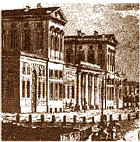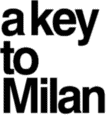























|
|
|
City Council's Art Collections
The 'Comune di Milano''s four art museums
are also formed mainly of private collections donated to the City
by their owners. There are some exceptional art works, plus very
well researched documentation on Milan's history from the Middle
Ages to the present day.

|
|


|
|
Civico Museo d'Arte Antica
del Castello
A wealth of works: Lombard sculpture from
the Middle Ages to the Renaissance, and Northern-Italian
painting up to the 18th century. The Civiche Raccolte
di Arte Applicata are also exhibited here: arms, antique furniture,
ceramics and an exceptional collection of hundreds of musical
instruments.
The museum's layout is modern and has been kept up-to-date, but
the charm of the first series of rooms stems from their older
layout which dates back to 1954-63. It is the result of the team-work
of BBPR (Banfi, Belgiojoso, Peressutti and Rogers). Identification
plates in solid wood, imaginative settings created without excessive
regard to expense, the tall shell-shaped panelling which encloses
the Rondanini Pietà by Michelangelo are solutions
that reflect the finest taste of the 1950's.
Outstanding in terms of sculpture
is the Monument of Bernabò Visconti by Bonino
da Campione (1360-80 circa), which comes from the demolished
church of San Giovanni in Conca. The Statue of Gaston de Foix
(1515-1523), by Agostino Busti called Bambaja, also comes
from a demolished church (in 1990 this monument reacquired its
originally intended appearance, thanks to the purchase of high-relief
sculptures and statues that had been made for the tomb of the
young French general but found their way into private collections).
The Rondanini Pietà, considered to be Michelangelo's
last work (1555 circa), was purchased by the City Council in 1952.
The Sala delle Asse now houses the Greppi-Belgiojoso collection
of Flemish paintings.
The paintings are at the first floor, after the antique
furniture collection (where you will also see the 15th century
frescoed Camera di Griselda, from Roccabianca, Parma).
Worthy of special mention are works by the Lombard schools
of the Renaissance (Foppa, Bergognone, Boltraffio, Bramantino,
Moretto) and of the 16th and 17th centuries (Cerano, Morazzone,
Cairo, Magnasco, Procaccini, Nuvolone). There are also works by
Mantegna, Lippi, Lotto, Tintoretto, Correggio, Bronzino, Tiepolo.
Paintings by Sebastiano Ricci, Carlo Preda, Montalto, Vermiglio
and Canaletto are among the recent acquisitions.
With the old BBPR-designed layout, you went straight from the
art gallery to the applied arts sections in the buildings
overlooking the Cortile della Rocchetta. Now, instead, you have
to go down to the entrance again, and from there take the staircase
on the left. Outstanding among the many exhibits - besides the
previously mentioned musical instruments - are the Arazzi Trivulzio,
a series of twelve tapestries of exceptional quality, size, completeness
and conservation; they were made (around 1504-09) in Vigevano
and depict the months of the year, to designs by Bramantino.
Since the 80s two exhibition rooms have been opened under the
Cortile Ducale: you can see a number of Roman inscriptions and
tombstones, medieval statues and bas-reliefs, Renaissance capitals
and medallions - very elegantly exhibited.
An overview of the Castello's collections
is not complete without the Gabinetto dei Disegni and the
Medagliere (which can be seen only upon specific request)
and without the Civica Raccolta Stampe 'Achille Bertarelli'
( 8.45AM-12 noon and 2.30-4.15PM, closed Saturday, Sunday
and public holidays; 8646 1404), whose entrance is next to
the Torre del Filarete. The Raccolta Stampe consists of more than
30,000 prints, maps, ex libris and visiting cards donated to the
City in the 20s by Bertarelli, who collected them assiduously.
These collections are filed as in a library, and you can see them
only as you would in a reference library.
|
|
inside the Castello Sforzesco
 |
Cairoli
|
9AM - 5:30PM
• closed Monday
entrance free
tel. 02 861125
|
|
Civiche Raccolte Archeologiche
e Numismatiche
These collections may have less appeal
for the public at large but they are still very interesting for
anyone with more than schoolboy knowledge of the subject. Their
largest portion - Greek, Etruscan, Roman
and Longobard exhibits - is located in the only place in
the city where there are still two Roman towers from the Imperial
period; namely, at the Monastero Maggiore. A good part
of the pieces were obtained from excavations in various areas
of Milan.
The Egyptian and palaeethnological
sections of the Raccolte Archeologiche are in the Castello ( same
opening hours as the Museo d'Arte Antica) in rooms beneath
the Rocchetta. The Egyptian part is not extensive (but has burial
chamber relics from the 7th century BC and some small statues
of notable interest), while the palaeethnological has a wider
and clearly presented collection of material found in Lombard
necropoleis from the Paleolithic to the Iron Age.
|
|
Corso Magenta 15
 |
Cadorna Triennale
|
9AM - 5:30PM
• closed Monday
entrance free
tel. 02 86450011
|
|
Civica Galleria d'Arte Moderna
The Gallery documents mainly Italian visual
artworks from late 18th century neoclassical Milanese
paintings to the early Avant-garde, through the phases
that go from Romanticism to Divisionism (the optical mixtures
technique used by the Neo-Impressionists). The Raccolta Grassi
(on the second floor), donated to the City Council in 1956, is
a permanent part of the gallery: it focuses on late 19th and early
20th century Italian and French art and includes numerous important
works by the Tuscan 'Macchiaioli' and above all - a rarity in
Italy - by French Impressionists and Post-Impressionists like
Corot, Manet, Cézanne and Gauguin. On the first floor is
the Museo Marino Marini, which provides a fascinating setting
for this Italian contemporary artist's work.
Among the neo-classical artists
represented here are Canova and Appiani, for the Romantics
Hayez and Faruffini, for the 'Scapigliati', Cremona and
Medardo Rosso, for the turn-of-the-century 'Divisionisti',
Segantini (The Two Mothers), Previati and Pellizza da Volpedo
- whose gigantic Quarto Stato is a sort of symbol of both
the Gallery and of the Milanese socialist traditions - ; for the
'Macchiaioli', Lega, Signorini and Fattori; for the Avant-gardes,
Balla and Boccioni.
The small building on the right of the
Villa Reale is the PAC (Padiglione d'Arte Contemporanea,
Via Palestro 14, tel. 02 783330). It is dedicated to excellent
temporary exhibitions of current contemporary art. PAC was conceived
to house the section of the Modern Art Gallery which was permanently
devoted to 20th century art. But the City Council's contemporary
art collections have been moved to the
|
|
Via Palestro 16
(inside the Villa Reale)
 |
Palestro
|
9AM - 5:30PM
• closed Monday
entrance free
tel. 02 76002819
|
|
CIMAC
Civico Museo di Arte Contemporanea
This is the first nucleus - on the top
floor, after interminable flights of stairs - of the future Galleria
di Arte Contemporanea, which should occupy a whole wing of
Palazzo Reale. There are two L-shaped corridors flanked by small
rooms each of which is dedicated to an artist or group of artists
belonging to the same period or school. One wing covers the years
from Futurism to the 50s, the other, from the 50s to the present
day. The most recent works are almost all donations, the majority
from the painters themselves.
The room dedicated to Boccioni's
work is outstanding. Other artists who also have an entire room
dedicated to their work are Giorgio De Chirico, Carrà,
Sironi, Martini, De Pisis, Melotti as established masters of Italian
contemporary art; and Novelli, Tancredi, Schifano, Rotella and
Paladino as more authentically current contemporaries.
There are ambitious plans to expand the
CIMAC, but these are not the only plans for the city's museums.
For quite some time a project to create a museum of fashion
design throughout the centuries has been seriously considered.
It would be set up in Villa Scheibler, once a Renaissance country
house now on the outskirts of Milan, and would occupy an exhibition
area of 2,700 square meters. The Castello's collections of period
costumes could thus be exhibited, since presently its Civiche
Raccolte d'Arte Applicata are not completely on show. In the future
fashion museum, alongside the historical costumes, the creative
works of some contemporary Milan based fashion designers would
be exhibited.
|
|
Piazza Duomo
(inside the Palazzo Reale)
 |
Duomo
|
currently close for restoration
(about one hundred pieces are temporarily been exhibited at La Permanente,
Via Turati 34, open Tuesday - Sunday 10AM - 1PM and 2:30PM - 6:30PM,
Thursday through 10pm, tel. 02 6551445, entrance fee)
web news
at CiaoMilano
|
|
All rights reserved
copyright © 1996-2001
Monica Levy, Roberto Peretta
copyright © 1996-2001
Ulrico Hoepli SpA, Milano

[Want to purchase
the guidebook ?]
[Instructions on how
to do it]
|
|
|
|